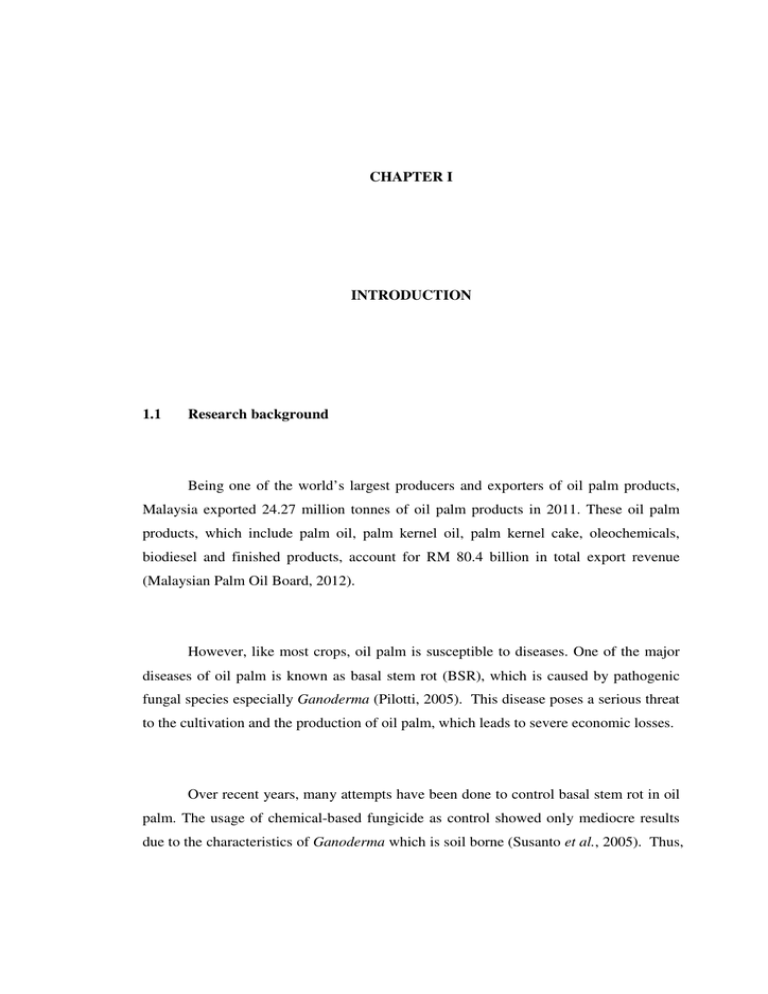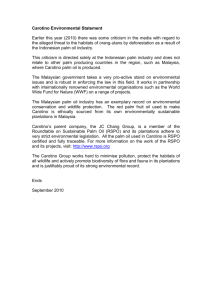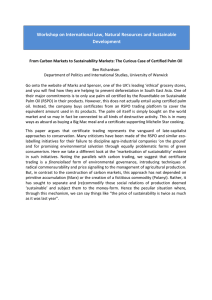Being one of the world’s ... Malaysia exported 24.27 million tonnes ... CHAPTER I
advertisement

CHAPTER I INTRODUCTION 1.1 Research background Being one of the world’s largest producers and exporters of oil palm products, Malaysia exported 24.27 million tonnes of oil palm products in 2011. These oil palm products, which include palm oil, palm kernel oil, palm kernel cake, oleochemicals, biodiesel and finished products, account for RM 80.4 billion in total export revenue (Malaysian Palm Oil Board, 2012). However, like most crops, oil palm is susceptible to diseases. One of the major diseases of oil palm is known as basal stem rot (BSR), which is caused by pathogenic fungal species especially Ganoderma (Pilotti, 2005). This disease poses a serious threat to the cultivation and the production of oil palm, which leads to severe economic losses. Over recent years, many attempts have been done to control basal stem rot in oil palm. The usage of chemical-based fungicide as control showed only mediocre results due to the characteristics of Ganoderma which is soil borne (Susanto et al., 2005). Thus, 2 researchers are currently focusing in studying the biological control of the disease using endophytic microorganisms including Pseudomonas, Trichoderma, and Hendersonia. One of the major advantages of using endophytic microorganisms as control is they can be easily introduced to the roots without causing harm to the host plants. Moreover, these endophytic microorganisms can suppress the growth of pathogens by limiting their nutrient and space. 1.2 Problem statement Hendersonia has been researched for its biological control properties, especially in controlling fungal diseases. Resulting from this, there is a growing need of these fungi in oil palm cultivations across Malaysia and other oil palm producing countries. Thus, in order to cater for these demands, there must be some means to produce this strain in large scale. In this study, we aim to design an efficient high cell density cultivation of Hendersonia sp. As of the time of writing this thesis, there has been no previous study on both shake flask and bioreactor cultivation of Hendersonia sp. 1.3 Research objectives The main objectives of this research are: (i) To establish a comprehensive Hendersonia sp. cultivation platform; (ii) To select the optimum medium for the cultivation of Hendersonia sp. 3 1.4 Research scope In order to achieve the objectives of this study, the scope of research were applied: (i) Medium screening for agar cultivation; (ii) Medium screening for shake flask cultivation; (iii) Medium optimization for shake flask cultivation; (iv) Effect of pH and agitation speed on cell growth in 150-L bioreactor.




